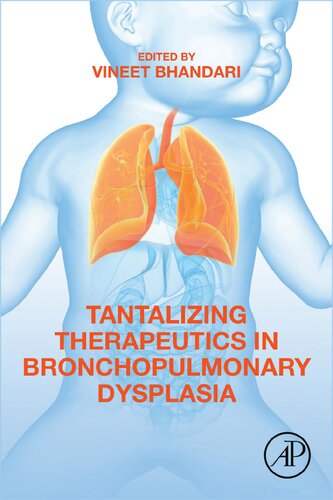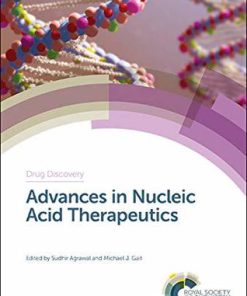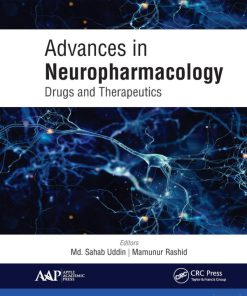Tantalizing Therapeutics in Bronchopulmonary Dysplasia 1st Edition by Vineet Bhandari ISBN 0128189916 9780128189917
$50.00 Original price was: $50.00.$25.00Current price is: $25.00.
Tantalizing Therapeutics in Bronchopulmonary Dysplasia 1st Edition by Vineet Bhandari – Ebook PDF Instant Download/Delivery: 0128189916, 978-0128189917
Full download Tantalizing Therapeutics in Bronchopulmonary Dysplasia 1st Edition after payment

Product details:
ISBN 10: 0128189916
ISBN 13: 978-0128189917
Author: Vineet Bhandari
Tantalizing Therapeutics in Bronchopulmonary Dysplasia is a concise reference that provides an overview of emerging concepts in the understanding of lung development and injury from a molecular and cellular point-of-view, including exciting pathways that are paving the way for new options to prevent or treat Bronchopulmonary Dysplasia (BPD). The book’s chapters are written by experts who are at the forefront of BPD research. Coverage includes chapters on exosomes, stem cells and miRs, as well as a section on new discoveries in BPD research with translational potential. This is a must-have reference for researchers, physicians and trainees working on BPD, lung developmental biology, and more.
- Includes discussions on which aspects of the bench research in Bronchopulmonary Dysplasia are the most promising areas
- Offers insights into the latest research being conducted that could potentially move to the bassinet (in the NICU)
- Contains evidence-based summaries and informed opinions about existing therapies
Tantalizing Therapeutics in Bronchopulmonary Dysplasia 1st Table of contents:
1. Current Therapeutics: State of the Art
1.1 Systemic and Topical Glucocorticoids to Prevent BPD
- Introduction
- Dexamethasone
- Dexamethasone and Hydrocortisone in the Brain: Different Actions, Different Outcomes?
- Hydrocortisone
- Other Systemic Steroids
- Topical Steroids (Inhaled and Instilled)
- Conclusion
- References
2. Use of Caffeine for Prevention of Bronchopulmonary Dysplasia
2.1 Overview of Caffeine in Premature Neonates
- Brief History of Caffeine Use in Premature Neonates
- Epidemiology of Caffeine Use
- Pharmacology of Caffeine in Premature Neonates
- Cellular Mechanism of Action of Caffeine
- Mechanism of Action of Caffeine for Prevention of BPD
- Dosing and Route of Caffeine Administration
- Drug Interactions with Caffeine
- Serum Drug Monitoring for Caffeine
- Timing of Caffeine Use: Early vs. Late
- Evidence for the Use of Late Caffeine for Prevention of BPD
- Evidence for the Use of Early Caffeine for Prevention of BPD
- Adverse Effects of Caffeine
- Caffeine and Neurodevelopmental Outcomes
- Caffeine Controversies
- What is the Optimal Duration of Caffeine?
- Is it Safe to Discharge Babies Home on Caffeine?
- Conclusions
- Recommendations
- References
3. Next-Generation Ventilation Strategies to Prevent and Manage BPD
3.1 Introduction
- Pathophysiology of Ventilator-Associated Lung Injury
- General Strategies to Prevent BPD
- Respiratory Support at Birth and Lung Injury
- Positive End-Expiratory Pressure (PEEP) in the Delivery Room
- Sustained Inflation (SI)
- Non-invasive Respiratory Support
- Less Invasive Surfactant Administration
- Lung-Protective Strategies of Mechanical Ventilation
- Volume-Controlled and Volume-Targeted Ventilation
- Volume-Controlled vs. Volume-Targeted Ventilation
- How Does Volume-Targeted Ventilation (VTV) Work?
- Documented Benefits of Volume-Controlled and Volume-Targeted Ventilation
- Clinical Guidelines for VTV in Preterm Infants
- Importance of the Open Lung Strategy
- High-Frequency Ventilation
- Neurally Adjusted Ventilatory Assist (NAVA)
- Airway Pressure Release Ventilation (APRV)
- Respiratory Support for Infants with Established BPD
- Conclusion
- References
4. Ongoing Therapeutic Studies with Translational Potential
4.1 Endpoints for Therapeutic Trials for BPD: Lessons Learned from Clinical Trials
- Limitations of Common BPD Definitions as Clinical Trial Endpoints
- Does BPD Diagnosis Predict Long-Term Outcomes?
- Is 36 Weeks Postmenstrual Age (PMA) the Optimal Timing for BPD Endpoints?
- Is 40 Weeks PMA a Better Endpoint?
- Single-Day Diagnosis vs. Protracted Hospital Stay for BPD Diagnosis
- Should BPD Diagnosis Be Based on Oxygen Use or Positive Pressure?
- Advantages of Graded Severity Scores for BPD
- Incorporating Pulmonary Function Tests (PFTs) as Endpoints in Clinical Trials
- Respiratory Death as an Outcome
- Defining Clinical Trial Endpoints After NICU Discharge
- Long-Term Clinical Trial Endpoints – How Long is Too Long?
- Conclusion
- References
5. Exogenous Surfactant in the Fight Against BPD
5.1 Conventional and Late Surfactant Therapy
- Conventional Surfactant Therapy and BPD
- Late Surfactant Therapy and BPD
- New Modes of Surfactant Administration
- Anti-Inflammatory and Immunomodulatory Effects of Surfactant
- Exogenous Surfactant Preparations in Clinical Use
- Newer Synthetic Surfactants
- Surfactant Proteins A and D
- Surfactant as a Vehicle for Anti-Inflammatory Therapy
- Surfactant Therapy: Right Place, Right Time, Right Patient
- Known Effects of Relevant Additives on Surfactant Biophysics
- Surfactant and Therapy Potency in BPD
- Specific Therapies Partnered with Surfactant
- Conclusion
- References
6. Stem Cells in the Treatment of BPD
6.1 Clinical Translation Challenges and Opportunities
- The Right Cells
- Sources of Stem Cells
- Allogenic vs. Autologous MSCs
- Standardization of MSCs
- Preconditioning of MSCs
- Genetic Engineering of MSCs
- The Right Patients
- The Right Route of Administration
- The Right Timing and Dose
- Long-Term Outcomes and Safety of MSC Transplantation
- Conclusions
- References
7. Extracellular Vesicles (EVs) in BPD Therapy
7.1 Introduction and Rationale for Stem Cell-Based Therapies
- EVs: Intro and Nomenclature
- EV Isolation Methods
- EV Characterization Methods
- EVs as Therapeutic Vectors
- EVs in BPD
- Acknowledgment
- References
8. Growth Factors in BPD Therapy
8.1 Introduction
- Insulin-like Growth Factor 1 (IGF-1)
- Vascular Endothelial Growth Factor (VEGF)
- Hypoxia-Inducible Factor (HIF)
- Platelet-Derived Growth Factor (PDGF)
- Pigment Epithelium-Derived Factor (PEDF)
- Endothelial Monocyte-Activating Polypeptide (EMAP II)
- Transforming Growth Factor Alpha (TGF-α)
- Transforming Growth Factor Beta (TGF-β)
- Connective Tissue Growth Factor (CTGF)
- Epidermal Growth Factor (EGF)
- Hepatocyte Growth Factor (HGF)
- Keratinocyte Growth Factor (KGF)
- Macrophage Migration Inhibitory Factor (MIF)
- Summary and Conclusions
- References
9. Antenatal Approaches in BPD Therapy
9.1 Antenatal Treatments to Prevent BPD
- Antenatal Targets to Decrease BPD
- Maternal Factors Influencing Fetal Lung Development
- Pre-existing Maternal Conditions (e.g., Hypertension, BMI, Toxin Exposure)
- Placental Factors Influencing Fetal Lung Development
- Inflammatory and Anti-inflammatory Micronutrients
- Abnormal Placentation (VEGF, IL-1 Antagonists)
- Fetal Growth Restriction (FGR)
- Intra-Amniotic Therapies (e.g., VEGF, Epidermal Growth Factor, Stem Cells)
- Antenatal Steroid Therapy and Other Approaches to Advance Lung Maturation
- Fetal Tracheal Occlusion, Intra-Tracheal Drug Delivery, Placental Replacement
- Conclusion
- References
10. miRs: Master Regulators in BPD Therapy?
10.1 Introduction
- MicroRNA and Early Lung Development
- MicroRNA and Late Lung Development
- MicroRNAs as Risk Predictors and Therapeutic Targets for BPD
- miRs and BPD’s Sex Predilection
- miRs and the Lung Microbiome
- Conclusions
- Funding
- References
11. Immune Modulators for the Therapy of BPD
11.1 Introduction
- Antenatal Corticosteroids
- Macrophage Migration Inhibitory Factor (MIF)
- MIF and BPD
- IL-1β and the NLRP3 Inflammasome
- Therapeutic Potential of IL-1RA (Anakinra)
- NLRP3 Inflammasome as a Therapeutic Target
- Surfactant Protein D and Neonatal Lung Disease
- Conclusion
- References
People also search for Tantalizing Therapeutics in Bronchopulmonary Dysplasia 1st :
treatment of bronchopulmonary dysplasia in neonates
bronchopulmonary dysplasia treatment in neonates
is bronchopulmonary dysplasia curable
neonatal bronchopulmonary dysplasia
new bronchopulmonary dysplasia
Tags:
Vineet Bhandari,Tantalizing,Therapeutics,Bronchopulmonary,Dysplasia 1st
You may also like…
Engineering
Engineering
Intelligent Hydrogels in Diagnostics and Therapeutics 1st Edition Anujit Ghosal (Editor)
Biology and other natural sciences
Earth Sciences - The Environment
Jurisprudence & Law
Philosophical foundations of tax law 1st Edition by Monica Bhandari ISBN 0192519379 9780192519375
Medicine - Pharmacology












